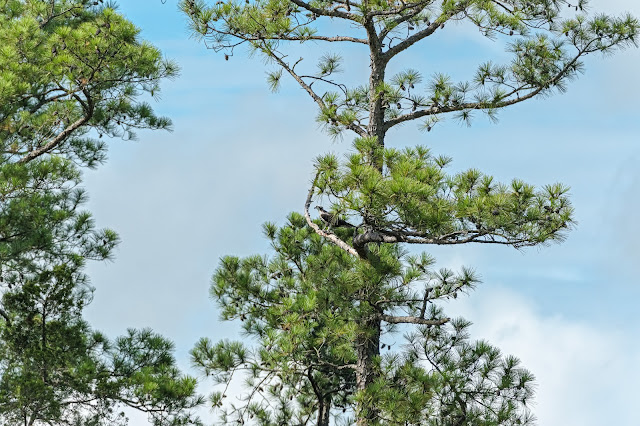During my initial outings with my new Fujifilm X-H2S, I made a few exposures of birds at a very long distance from the camera. My goal for even pressing the shutter was just to see if the camera’s subject detection AF for birds would lock onto at distances farther than expected. In other words, when the birds were so small in the frame that one wouldn’t consider making the photograph. I’ve shown two examples here of that.
First, I was standing on a pier looking across a wetland at a tree where I knew that a Bald Eagle’s nest was located. I couldn’t see any eagles in the nest but then I noticed a bird fly in from the right and land in an adjacent tree. I couldn’t identify it so I pointed the camera and lens toward the area in which it landed and was surprised to see it was an osprey. The three exposures I fired off all looked sharp. See the images below as to how the osprey image stood up to extreme cropping.
The second image here was made while looking for birds on another pier. I spotted an egret fishing in ankle deep water about 200 yards away. I aimed the 100-400mm lens at it and, again, made three exposures (I had the camera set for 10fps and a quick push of the shutter would make three exposures). The bird subject detection not only picked up the egret but locked on to its head. Again, all three images looked to be sharp in the LCD.
After looking at these two subjects in Lightroom Classic I was really pleased at how sharp and detailed they were. So, I thought I would have a little fun and see just how much detail I could get out of these two files before they broke down.
For each, I converted them to DNG files using Iridient X-Transformer. If you haven’t used this little program (also a LR plug-in) you would be surprised at how much better it converts an X-Trans file than does Lightroom. Much more tiny detail is visible. For example, In LR I could see a bit of foliage ‘mush’ at extreme enlargements while Iridient is able to bring out detail in that foliage.
I then edited the files to my liking, cropped them significantly, then sent the files to Topaz Gigapixel AI to be upsized. I then cropped them really tightly again. The cropping sizes are in the photo's captions.
 |
| This crop is about 10% of the image above or about 2.5mp. (click to enlarge) |
For the egret image, I cropped the original 26mp file to about 2.5mp or about 10%. I then sent the file to Topaz Gigapixel AI and upsized it 400% to 10mp. I then took that file and cropped it again to 2.5mp.
 |
| I spotted this egret about 200 yards from my location. (click to enlarge) Fujifilm X-H2S; 100-400mm f/4.5-5.6 lens @ 400mm; 1/1000th sec. @ f/5.6; ISO 640; handheld |
 |
| This was cropped to about 10% of the photo above or 2.5mp. (click to enlarge) |
 |
| The file above was sent to Topaz Gigapixel AI were it was upsized 400% to 10mp, then cropped again down to 2.5mp. (click to enlarge) |
It was fun seeing how much I cold coax out of an X-2HS file. Of course there were two other important factors that helped these images retain detail other than the new sensor. Those were the quality of the lens itself, which is excellent, as well as the improved image stabilization in the camera coupled with the image stabilization in the lens.
As I have mentioned in the past, with the advent of sophisticated artificial intelligence based plug-ins coupled with the excellent quality of all format sensors in the newest cameras, an APS-C camera may no longer be much of a disadvantage in the vast majority of photographic circumstances. Technology is the 'great equalizer,' as I have said many times before.
Thanks for looking. Enjoy!
Dennis A. Mook
All content on this blog is © 2013-2022 Dennis A. Mook. All Rights Reserved. Feel free to point to this blog from your website with full attribution. Permission may be granted for commercial use. Please contact Mr. Mook to discuss permission to reproduce the blog posts and/or images.


No comments:
Post a Comment